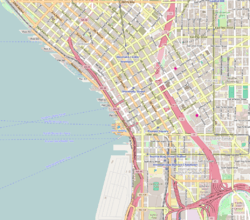German House (Seattle)
| German House | |
|---|---|
 German House in 2013 (featuring the recently opened Kafe Berlin) | |
| Former names | Assay Office |
| Alternative names | German Club |
| General information | |
| Location |
613 9th Ave Seattle, Washington, U.S. |
| Completed | 1886 |
| Designated | July 6, 1983 |
|
Assay Office | |
 | |
| Coordinates | 47°36′22″N 122°19′25″W / 47.60611°N 122.32361°WCoordinates: 47°36′22″N 122°19′25″W / 47.60611°N 122.32361°W |
| Built | 1886 |
| NRHP reference # | 72001271[1] |
| Added to NRHP | March 16, 1972 |
German House is a building in the First Hill area of Seattle, Washington, which since its construction in 1886 has variously functioned as an office block, an entertainment hall and, until 1932, the city's assay office. Following World War II the building returned to the possession of its previous German-American owners; it continues today to be a popular venue for German-themed events in Seattle. It was designated a Seattle Landmark in 1983.[2] It was listed on the National Register of Historic Places as Assay Office in 1972.
History
The structure's history dates back to 1886 when local newspaper publisher and civic leader Thomas Prosch built it to function as both an entertainment center and office block under the name of Prosch Hall. Prosch was also a collector of photographs by local photographers[3] and wrote books on the Puget Sound region.[4] It was taken over by the Federal government with the support of the Seattle Chamber of Commerce and used as an assay office from July 1898 due to the need of gold miners in the Pacific Northwest to have such an establishment in closer proximity (previously the nearest assay office had been in San Francisco). By the following year it was taking in more gold than any other assay office in the United States.[5]
By the late 1920s gold deposits had declined markedly and, in 1932, the building ceased to be used as an assay office. In 1935 the building was taken over by Deutsches Haus (German Club), an organization for Seattleites of German descent, becoming their social center. It was used as a Navy entertainment center during World War II before returning to the possession of its previous German owners.[6][7] Today, its affairs are administered by the German Heritage Society in Seattle; it plays host to a diverse array of Germanic activities including traditional concerts and balls. Lectures on the building's historic roots have also taken place here.[8]
On July 6, 1983, the city of Seattle's Landmark Preservation Board designated German House as a Seattle Landmark. It had previously been added to the National Register of Historic Places in March 1972.[1][9]
In November 2011 a German-themed café named "Kafé Berlin" opened on the first floor of the building; however, by 2016 it had closed permanently.[10][11]
References
- 1 2 National Park Service (2013-11-02). "National Register Information System". National Register of Historic Places. National Park Service.
- ↑ "Designation as Seattle Landmark, 1983" (PDF).
- ↑ "Archives West: Thomas Prosch Seattle Views photograph albums, circa 1851-1906". archiveswest.orbiscascade.org.
- ↑ "Archives West: Thomas Wickham Prosch papers, 1775-1915". archiveswest.orbiscascade.org.
- ↑ Bagley, Clarence. History of Seattle: Volume 2. p. 252. ISBN 978-3-849-67862-3.
- ↑ Hard Drive to the Klondike: Promoting Seattle During the Gold Rush nps.gov
- ↑ Berlin Bakery Beatdown at 9th and James, 1905 and 2011 capitolhillseattle.com
- ↑ "German Heritage Society - Historic Seattle".
- ↑ Margaret A. Corley (June 1969). "National Register of Historic Places Inventory/Nomination: German Club / Assay Office". National Park Service. Retrieved July 6, 2018. With accompanying photo from 1950s
- ↑ Ich bin ein Kafe Berliner — German-styled cafe celebrates grand opening on First Hill capitolhillseattle.com
- ↑ Coffee Tree & Poke constructing tasty First Hill Tower Capitol Hill Times. August 11, 2016